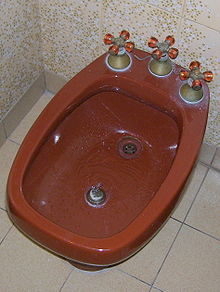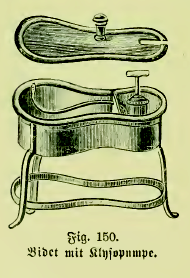bidet
A bidet ( French , [ biːdeː ]) is a low seat washbasin . It is used to clean the genitals , anus and feet . Unlike the shower toilet , a bidet is installed in a bathroom in addition to the toilet.
Use and designs
Bidets are generally used to cleanse the external sexual organs and the anus with water. In addition, other parts of the body - especially the feet - can also be cleaned easily. Although the bidet looks similar to the toilet, the comparison with the sink or bathtub is more appropriate.
In most cases, water is drained into the bidet and the external genitalia is washed like a bowl. In other cases, the bidet acts like a shower that sprays water from below and can be regulated to the desired heat using a fitting. Basically, the bidet should always be used after using the toilet. This prevents unintentional leaks of urine and stool in the bidet. After washing in the bidet, the body parts should also be dried off. Here towels or toilet paper that have been specially provided can be useful. Some bidets are equipped with air dryers. Although using a bidet involves using the hand that touches the genitals and anus, using it is more hygienic than cleaning with just dry toilet paper . In practice, most people use both: first the toilet paper for rough cleaning and then the bidet for fine hygiene.
Bidets are produced in different designs. Today they usually have a tap with which water can be filled into a porcelain basin. If you put a plug in the drain , the bidet can be filled, or the water can be drained while in use. Other bidets have a nozzle from which water is sprayed.
For people with limited mobility who have problems using the bathtub or who are afraid of slipping in the shower , the bidet is a great way to ensure personal hygiene .
distribution
According to a French survey from 1995, in Europe the bidet is most frequently used in Italy (97%), followed by Portugal in second place (92%) and France in third place (42%). The bidet is used the least in Germany (6%) and Great Britain (3%). Due to the low prevalence in some countries, portable hand-held bidets or subsequently installable bidet hoses have been developed.

history
400 years ago, bidet was the French word for “little horse” - in old French, bider means trot. This strange etymology came about because early forms of bidets were attached to a frame and you had to step up to use them.
The bidet appears to be an invention of French furniture makers in the late 17th or early 18th centuries. The exact date or name of the inventor is not known. The earliest literary source of a bidet can be given as the year 1710. Roberto Zapperi cites 1726 as the earliest written mention of the bidet and the memoirs of the French Foreign Minister René Louis d'Argenson as the source . The earliest known pictorial representation of a bidet is the painting La Toilette intime by François Boucher from 1741, which is now in the museum in Madrid. One of the greatest advocates of the bidet was the French ambassador in Venice and Rome, François-Joachim de Pierre de Bernis, through whom the bidet found its way into Italy.
Around 1900, due to the advanced plumbing technology of the Victorian era, the bidet and chamber pot moved from the bedroom to the bathroom .
Until the birth of the birth control pill , the bidet was used for contraception by trying to prevent pregnancy by washing the sperm out of the vagina after intercourse.
In the humorous novel The Blue Bidet or The Real Life of Joseph Breitbach , published in 1978, the main character is a vehement advocate of the bidet, always tries to convince his counterpart of its usefulness and completely loses his composure if there is none in a hotel bathroom. Also Hobbythekmoderator and author Jean Puetz is a big advocate of using bidets for anal washing and personal hygiene.
literature
- Roberto Zapperi: Too much moralism makes the body dirty. Why the bidet is common in some places and not elsewhere. In: FAZ No. 95, April 24, 2010, Z3.
Web links
Individual evidence
- ↑ Bidet: A must in every bathroom at heimhelden.de, accessed on March 22, 2018.
- ↑ a b c Roberto Zapperi: Too much moralism makes the body dirty. In: FAZ, April 24, 2010.
- ↑ On the German manufacturer HappyPo in Kurier (daily newspaper) online, accessed on December 1, 2019
- ↑ Interview with the founder of Nadeef, a Canadian company , accessed on December 1, 2019
- ^ Scientific advice of the Duden editorial team (ed.): Duden, German Universal Dictionary. 6th edition. Dudenverlag, Mannheim / Leipzig / Vienna / Zurich 2007, ISBN 978-3-411-05506-7 , page 302.
- ↑ The bidet is a vaginal washer at de.muvs.org, accessed on March 22, 208.
- ↑ Spiegel Online: Women's shower and sheep intestinal condom: The history of contraception .
- ↑ All about the Po - healthy care inside and out at jean-puetz-produkte.de, accessed on March 22, 2018.


